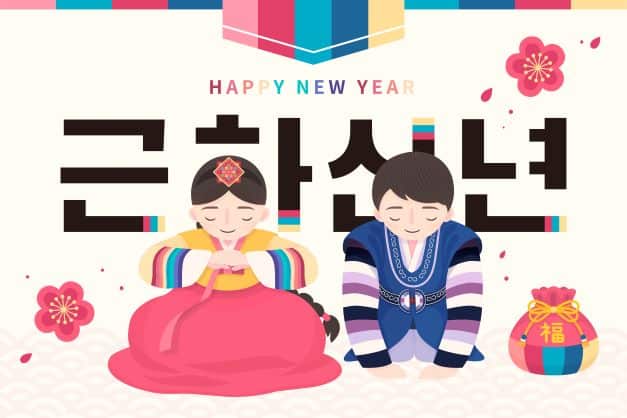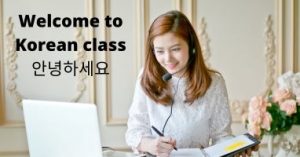Korean New Year Seollal
The Korean New Year, or Seollal (설날), is an important annual celebration for Koreans. It is a time to celebrate with family, and it is also one of the biggest festivals in Korea. The holiday lasts three days: one day before Seollal, on Seollal itself, and one day after Seollal. The first day of the new year is determined by the solar calendar, and in 2023, the first day of Seollal falls on January 22nd. Let’s explore how Koreans celebrate their new year.

Koreans celebrate Seollal by performing ancestral rites called charye (차례), and by eating foods that symbolize good luck. The ancestral rites are performed at the jesa table. Jesa means ancestor memorial. This is a special table set with food and drink offerings for deceased family members, which are placed on a raised platform in their honor. The table is decorated with flowers and food offerings. During the ritual, all family members bow three times before the ancestors’ portrait, which is placed on top of the jesa table. Then they offer food and drinks to them: rice cakes called songpyeon (송편), roasted chestnuts, sweet potatoes or soybean soup, brown beans or doenjang (된장) and other delicacies as well as red envelopes filled with money. It is also customary to give New Year’s wishes by writing them on red paper folded like flowers that are then put into tiny bottles or bowls filled with water that was boiled in pans used specifically for this purpose only during Seollal.
For Korean families who live in Korea or abroad, this ritual usually involves visiting a temple and offering prayers for deceased ancestors. You can also perform these ceremonies by yourself at home; just make sure to clean up afterwards!
The foods eaten during Seollal are made from ingredients that symbolize good luck: tteok (rice cakes), ddeokguk (rice cake soup), mandu (dumplings) filled with mung bean paste or meat fillings and covered in sesame seeds. These dishes represent special meanings: tteok symbolizes years of peace, ddeokguk symbolizes prosperity, mandu symbolizes fertility, and sesame seeds symbolizes longevity.
Another important custom is sebae, which involves deep bows to elders (depicted in the picture). The traditional way of sebae on Seollal involves three bows: one from the waist and two from the knees. It shows respect, gratitude and love at the same time—not surprising given how important elders are in Korean society. The first bow shows that you’re grateful for all that your grandmother (and everyone else’s) has done for you; she in turn will also thank her mother by holding a special ceremony called “jang-maeng.” The second bow show how much she means to you; it also lets her know that you are thinking about her even though she isn’t physically with you now. Finally comes a third (and final) bow: simply do this any time during the day while thinking back on all those cherished moments together over the years.
After sebae, elders give younger family members money in sebaetdon (red envelopes); this is usually given to unmarried young adults. All the sebaetdon received is put into a fortune pouch or bokjumeoni. You are expected to return the favor when your parents get older, so it is considered bad luck if you don’t give back the money!
Traditionally, children wore hanbok on Seollal. However, nowadays people are more likely to dress casually. As a general rule, people wear hanbok on Seollal. Hanbok (한복) refers to the traditional clothing worn in Korea. In fact, it is not one single piece of clothing but rather a category that covers several types of garments:
- Goreum (고름): The outermost layer worn outside the home, usually over pants or skirts called soksae (속새). They used to be made out of silk and were often embroidered with intricate designs. However nowadays most are made from cotton fabrics and are simple in design.
- Jeogori (저고리): A jacket-like garment worn over your gorem for both men and women alike; for women it tends to be more fitted than for men who tend towards looser fitting garments
- Dongbibap (동빛 바판): A traditional winter coat which has become an iconic symbol associated with Seollal because children wear them during their school celebrations on Seollal Day
- Yeopjeon Baji 역 전 바지: Pants that have become popular among young people due their comfortability
Family members also gather to play traditional Korean games during Seollal, such as yunnori (윷놀이), jegichagi (제기차기), and neolttwigi (널뛰기). Yunnori essentially is a board game that uses a game board, four wooden sticks called yut that is used like a dice, and eight tokens divided into two teams. In jegichagi, player will try to kick a shuttlecock using one foot continuously and the player with the most kicks wins. Jegichagi can also played as a team game where the shuttlecock is passed from one player to another using a foot kick. Neolttwigi is a game for girls where each stand at the end of a seesaw, one girl jumps and lands at one end, propelling the other girl into the air.
Another tradition of Seollal is pyebaek, where a married woman’s first visit post-wedding is to her husband’s parents’ house. The bride brings fruit and ddeokguk as gifts; these are exchanged for cash and fruit from her in-laws. Pyebaek is a very old Korean custom. It means “first visit”, and it involves a newly married woman visiting her in-laws’ house for the first time. There are many different rules that have evolved over time, but generally speaking this first visit to your husband’s parents’ house must occur within 30 days after the wedding day. Pyebaek is an important part of Korean culture, because it helps establish relations between families—and especially between mothers-in-law and daughters-in-law—who may not see each other again until Seollal rolls around next year.
We hope this article has helped you learn more about the Korean New Year, Seollal. If you’re interested in learning more about Korean culture and traditions, sign up for a Korean class with ALS today.



